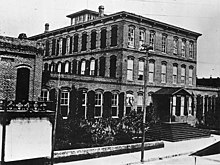Vicente Martinez Ybor
Vicente Martinez Ybor | |
|---|---|
| File:Vicente Martinez-Ybor.JPG V.M. Ybor circa 1890 | |
| Born | Vicente Martinez Ybor September 7, 1818 |
| Died | December 14, 1896 |
| Occupation(s) | industrialist, cigar manufacturer |
| Known for | founder of Ybor City |
| Spouse(s) | Palmia Learas, Mercedes de las Revillas |
Vicente Martinez Ybor (September 7, 1818 - December 14, 1896) was a Spanish American industrialist and cigar manufacturer, best known for founding the cigar-manufacturing town of Ybor City near Tampa, Florida in 1886.
Early life
Ybor was born in Valencia, Spain, in 1818.
Cuba
At the age of fourteen he emigrated to Cuba in 1832, in part to avoid the military service then mandatory for all male Spaniards,[1] and took a job as a grocery clerk before learning the cigar business.[2] In 1848, Ybor married Palmia Learas, and they had four children before her death.[1]
In 1856 Ybor founded his own company in Havana, Cuba and began manufacturing his El Principe de Gales ("Prince of Wales") brand.[3] The brand quickly became popular, and Ybor's factory was soon producing 20,000 cigars a day.[2] In his personal life, Ybor remarried in 1862. He and his wife Mercedes de las Revillas would have eight additional children.[1]
Tampa, Florida, United States
In 1868, the Ten Years' War broke out as Cubans fought to win their independence from Spanish colonial rule. Even though he was a Spaniard, Ybor sympathized with the Cuban cause and was accused (correctly) with providing funds to Cuban rebels. He was threatened with arrest and slipped out of Cuba to Key West, Florida in 1869.[3]
Ybor quickly built a new factory to continue manufacturing his Principe de Gales brand, employing many Cubans who had also left their homeland due to the war. Though his business prospered, conflict between Spanish and Cuban workers, labor unrest, and the difficulty of transportation to and from the island city eventually led Ybor to search for another site.[3]

With the enticement of a subsidy from Tampa's Board of Trade, Ybor purchased 40 acres (160,000 m2) of scrubland northeast of Tampa, Florida in October 1885. By the following spring, Ybor, along with business partners Eduardo Manrara and Ignacio Haya and planner Gavino Gutierrez, had built a company town dubbed Ybor City.His cigar factory, an imposing brick complex that filled a city block, was the largest in the world at the time.[3]
Ybor sought to avoid the constant labor unrest he had struggled with in Key West by providing what he considered good wages and living conditions. His company built small houses that his workers could purchase for cost, hoping that home ownership would keep his employees from migrating back and forth to Cuba, as was common practice among cigar workers in those days. Ybor encouraged other cigar factories to move in to increase the pool of workers, and welcomed entrepreneurs who founded businesses in the area. He also ran a variety of other businesses catering to the growing community, including a brewery, a hotel, an ice factory, and a brick factory, among many others.[4]
Ybor's plan worked. After a slow start, both his business and Ybor City as a whole flourished, with the area's cigar factories hand-rolling and shipping tens of millions of cigars annually by the late 1880s, the number increasing into the hundreds of millions by the turn of the 20th century. The initially independent town was annexed by the city of Tampa in 1887 and continued to grow and prosper for several decades.[3]

Death
When Ybor died in December 1896 at the age of 78, the headline of the Tampa Tribune read "Great Benefactor Gone.".[1] He owned so many business ventures and real estate in the area that his partners concluded that there was not enough available capital in Tampa to turn his assets into money. His family did sell off most of his holdings, but it took almost 10 years to do so.[4]
Vicente Martinez-Ybor is buried in Oaklawn Cemetery in downtown Tampa. In honor of his contributions to the area's development, his bronze likeness was installed at the front of the Centro Ybor shopping area located in Ybor City's traditional commercial district on 7th Avenue.
See also
History of Ybor City
History of Tampa, Florida
References
- Muniz, Jose Rivero (translated 1976) [1954]. The Ybor City Story: 1885-1954. translated by E. Fernandez and H. Beltran. private printing.
{{cite book}}: Check date values in:|date=(help) - Lastra, Frank (2006). Ybor City: The Making of a Landmark Town. University of Tampa Press. ISBN 159732003X.
External links
- Historical markers relating to V.M. Ybor in Ybor City
- Cameron B. LeBlanc, "Preserving the Memory of Ybor City, Florida", Southern Spaces, 22 December 2009.
